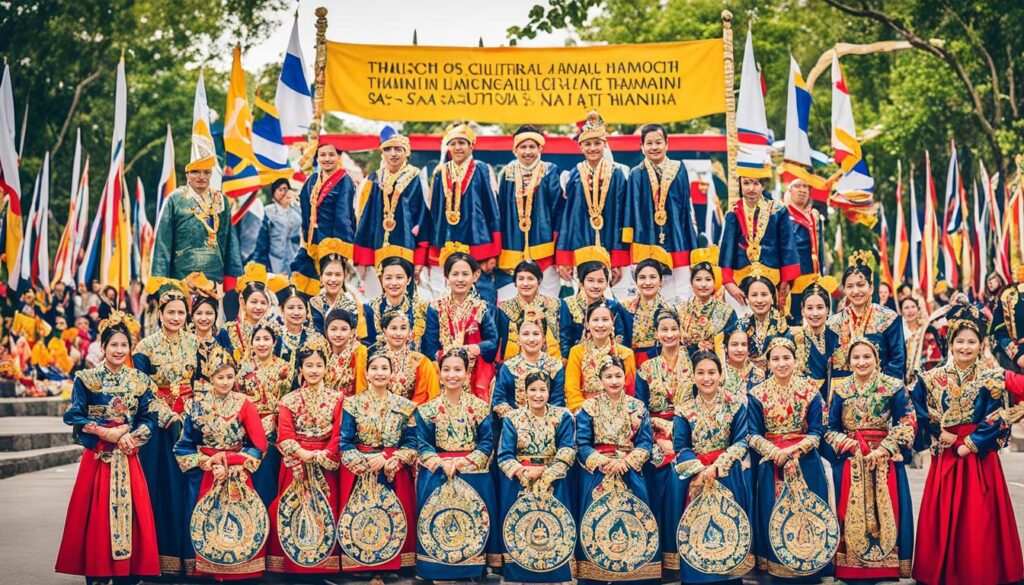Did you know that there are only 10 to 15 people left who can speak Sa’och, a nearly extinct language of Thailand? This dying dialect, part of the Pearic language family, is in urgent need of preservation and revitalization efforts. In this article, we will explore the linguistic features, historical background, and current status of Sa’och. Join us on this linguistic journey to discover the unique characteristics of Sa’och and the importance of preserving this cultural heritage.
Historical Background of Sa’och Language
The Sa’och language has a rich history that can be traced back to the 13th century. The Sa’och people, known for their close ties to the sea, have developed an extensive vocabulary related to fishing and marine life. This linguistic connection reflects their deep-rooted relationship with the ocean and its resources.
“The Sa’och people’s unique vocabulary reflects their profound understanding and dependence on the sea. Their language serves as a window into their rich cultural heritage.”
In the 19th century, members of the Sa’och minority were captured by a Thai admiral and brought to Thailand as slaves. This forced migration resulted in the presence of Sa’och communities near Kanchanaburi in Western Thailand. Despite the upheaval and dispersion of the Sa’och population, remnants of their language managed to survive in these new surroundings.
Unfortunately, the defeat and dispersal of the Sa’och had a significant impact on the use and transmission of their language. The younger generations, in particular, began to abandon the language, leading to a decline in its usage and endangerment.
To fully grasp the historical context, it is important to explore Sa’och language’s origin and geography. By understanding the origins and geographic distribution of the Sa’och people, we can gain insight into the factors that have shaped their language over time.
Origin of Sa’och Language
While the precise origins of the Sa’och language remain unclear, it is part of the Austroasiatic language family, which includes prominent languages such as Khmer and Vietnamese. Sa’och is considered a distinct language within this family, with its own unique features and characteristics.
The linguistic diversity within the Austroasiatic language family illustrates the ancient roots and complex linguistic landscape present in Southeast Asia. Sa’och’s linguistic heritage is an integral part of this intricate web of languages and cultures.
Geography of Sa’och Language
The Sa’och language is primarily spoken in Cambodia and Thailand. While the Sa’och people are native to Cambodia, the presence of Sa’och communities in Western Thailand is a result of historical events and migration.
Geographically, Sa’och-speaking regions are characterized by their proximity to the sea, with coastal areas providing the backdrop for the Sa’och people’s unique way of life. The language’s association with maritime activities reflects the Sa’och community’s historical reliance on fishing and their close connection to the ocean.
To gain a deeper insight into Sa’och language history, origin, and geography, let’s take a moment to visualize the geographic distribution and present an overview of the Sa’och-speaking regions.
| Country | Regions |
|---|---|
| Cambodia | Various provinces |
| Thailand | Kanchanaburi province |
By examining the history, origin, and geography of the Sa’och language, we can better understand its significance and the challenges it faces in the present day. The journey of the Sa’och language is a testament to the complex interplay between culture, history, and language evolution.
Linguistic Features of Sa’och Language
Sa’och is a unique language that showcases distinct phonetic and phonological elements. Let’s explore the key linguistic features that characterize the Sa’och language:
Phonetics:
In terms of Sa’och language phonetics, it adheres to the typical inventory found in modern Mon-Khmer languages. The phonetic system of Sa’och consists of 21 consonant phonemes that contribute to its distinct sound patterns.
Phonology:
The phonology of Sa’och language revolves around the contrasting qualities of its vowels. It encompasses a total of nine vowel qualities, which can either be pronounced as short or long sounds. This characteristic adds richness and variety to the spoken Sa’och language.
Moreover, it is important to note that Sa’och is not a tonal language. However, it does possess a fascinating four-way contrast of vocal register or phonation within its vowel system, underscoring the language’s unique phonological intricacies.
Alphabet:
The Sa’och language is written using its own unique alphabet. This alphabet serves as the written representation of the language, allowing for the documentation and preservation of the linguistic heritage of the Sa’och people.
The following table provides a comprehensive overview of the Sa’och language’s phonetic and phonological features:
| Element | Description |
|---|---|
| Consonant Phonemes | 21 |
| Vowel Qualities | 9 |
| Tonal Characteristics | Non-tonal, but with a four-way contrast of vocal register or phonation |
| Alphabet | Unique Sa’och alphabet |

Current Status of Sa’och Language
The Sa’och language is currently facing the risk of extinction, with only 10 to 15 speakers remaining. Efforts are being made to revitalize the language and preserve its linguistic heritage. Local schools have taken the initiative to teach Sa’och as a way to combat the decline of the language. The Ministry of Education has also recognized the importance of Sa’och language education and has allowed for the teaching of both Khmer and Sa’och in local schools. This step not only promotes language revitalization but also encourages cultural diversity and inclusivity.
Additionally, ongoing documentation efforts are taking place to record and preserve the Sa’och language for future generations. Linguists and language enthusiasts are working diligently to document the grammar, vocabulary, and unique linguistic features of Sa’och. By documenting the language, valuable resources are created that can aid in language revitalization and provide a foundation for Sa’och language education.
“Language is more than just words; it carries the essence of a culture.”
The Sa’och language speakers, though few in number, are at the forefront of this revival movement. Their dedication and efforts are commendable as they play a crucial role in preserving their language and passing it on to future generations. The Sa’och language revitalization movement encompasses not only linguistic aspects but also cultural heritage and identity preservation.
Through the collective efforts of the Sa’och community, linguistic experts, and educational institutions, there is hope for the future of the Sa’och language. By promoting Sa’och language education, documentation, and cultural awareness, the valuable linguistic and cultural heritage of the Sa’och people can be preserved, celebrated, and shared with the world.
Importance of Preserving Sa’och Language
The preservation of the Sa’och language is crucial for maintaining the cultural heritage and identity of the Sa’och community. The language holds valuable knowledge about the history, traditions, and way of life of the Sa’och people. It is an integral part of their cultural and social identity.
By preserving the Sa’och language, we can ensure that future generations have access to this unique linguistic heritage. It allows individuals to connect with their roots and understand the rich cultural tapestry of the Sa’och community.
“Language is not just a medium of communication; it is the carrier of cultural values, beliefs, and practices. Preserving the Sa’och language means safeguarding our identity and transmitting our heritage to the next generation,” says Chirativardhana Sa’och, a Sa’och community leader.
Language revitalization efforts play a significant role in preserving the Sa’och language. Through language classes, workshops, and cultural events, community members are actively involved in keeping the language alive. These initiatives not only help preserve the Sa’och language but also contribute to the overall well-being and empowerment of the Sa’och community.
The Sa’och language is the key to understanding the unique customs, rituals, and wisdom of the Sa’och people. It fosters a sense of belonging and strengthens the bonds within the Sa’och community. By valuing and preserving their language, the Sa’och community can ensure the continuity of their cultural heritage for generations to come.

Preserving the Sa’och Language Benefits:
- Preservation of cultural heritage
- Maintenance of Sa’och community identity
- Transmission of historical knowledge and traditions
- Strengthening community bonds
- Empowerment of the Sa’och community
Conclusion
The Sa’och language, with only a handful of speakers remaining, stands on the brink of extinction. However, there is still hope for its preservation through concerted efforts in education, documentation, and community engagement. It is imperative to raise awareness about the significance of the Sa’och language and provide the necessary support for its revitalization.
By preserving the Sa’och language, we not only safeguard a unique linguistic heritage but also ensure the continued cultural and linguistic diversity of Thailand. The Sa’och language holds invaluable knowledge about the history, traditions, and way of life of the Sa’och community. Its preservation is essential for maintaining their cultural identity and fostering a sense of belonging.
Educational initiatives that incorporate the teaching of Sa’och in local schools, alongside the dominant Khmer language, are crucial for revitalizing the language among younger generations. Additionally, efforts in documentation, such as recording and archiving Sa’och language resources, are essential for future linguistic studies and the transmission of knowledge.
Preserving the Sa’och language is not only a matter of linguistic conservation but also an act of cultural preservation. It is a testament to the rich cultural heritage of the Sa’och community and their contributions to the tapestry of Thai society. By working together to revitalize and conserve the Sa’och language, we can ensure a future where linguistic diversity is celebrated and cherished.
FAQ
What is the Sa’och language?
The Sa’och language is an endangered Pearic language spoken in Cambodia and Thailand. It is part of the Austroasiatic language family and has two dialects.
How many speakers does the Sa’och language have?
The Sa’och language currently has only 10 to 15 speakers remaining, making it nearly extinct.
What are the linguistic features of the Sa’och language?
The Sa’och language has 21 consonant phonemes, contrasts nine vowel qualities, and has a four-way contrast of vocal register or phonation in its vowel system. It has its own unique alphabet.
How is the Sa’och language being preserved?
Efforts are being made to revitalize the Sa’och language, with some local schools teaching it and ongoing documentation projects to record and preserve the language.
Why is it important to preserve the Sa’och language?
Preserving the Sa’och language is crucial for maintaining the cultural heritage and identity of the Sa’och community. It holds valuable knowledge about their history, traditions, and way of life.
